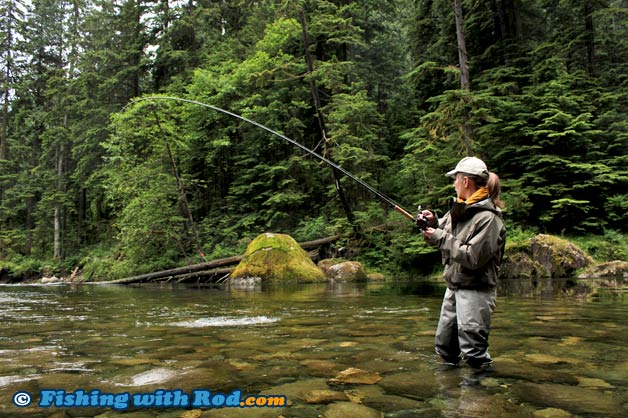Capilano River, North Vancouver
By Rodney Hsu

Although it is only short drive from Downtown Vancouver, the Capilano River offers some of the best salmon fishing opportunities in the Lower Mainland. Because of the Capilano River hatchery, urban anglers can enjoy chinook and coho salmon fishing between early spring and late fall.
While the current hatchery operated fisheries seem rather productive, its glorious past has unfortunately been forgotten by most Lower Mainland residents. Fueling the demand for freshwater by the city, the dam has blocked the passage of salmonid migration and flooded most of the spawning habitat in this watershed for many decades. What once was one of the most productive steelhead streams in Southern British Columbia, is lucky to only have a few of these prized sportfish returning today. Beside the hatchery program, many new projects have been initiated in recent years as attempts to reverse the damages that were done in the past. These include creation of spawning habitat in tributaries of the reservoir and upgrade of the dam so a safe passage can be created for juvenile salmon.
The fishable section of the Capilano River is only several kilometres long, from the boundary just downstream from the hatchery to the river mouth. Access is further limited by private properties and dangerous terrain in the canyon. It is a wise idea to hike the trails and be familiar with the area first before your first fishing trip if you are unfamiliar with this river.
How to Get There?
There are several main access points to the Capilano River. The hatchery parking lot is the easier spot to park your car. Downstream from the parking lot, a network of trails on both sides of the river can take you to various fishing locations.
The lower section of the river can be accessed from the Capilano River Road just under the Highway One Bridge. Upstream and downstream from here, several spots can be accessed quite easily.
Fishing Season
Fishing can be done throughout the year on the Capilano River. It is known to produce coho salmon as early as in April and May. The early coho salmon run typically peaks in June and part of July. While coho salmon can still be caught throughout the summer months, the river is usually quite low so fresh fish rarely migrate into it during this time.
Fishing for chinook, coho, chum and pink salmon usually improves in October when water level rises due to heavy rainfall. The fishing results depend highly on the water level. It is often hit and miss, because the water level fluctuates rapidly due to the dam water release.
Both summer and winter steelhead runs exist in the Capilano River. Summer steelhead are often found between July and September, while winter steelhead are usually encountered between January and May. It is important to note that ALL steelhead (both wild and hatchery marked) are required to be released. Please treat this catch and release fishery with great care while the populations are being rebuilt.
Fishing Techniques
When coho salmon emerge in the Capilano River in April and May, float fishing with a variety of bait such as freshly cured roe, dew worm, deli shrimp, ghost shrimp, rubber bait is the most effective method for targeting these hungry fish. If fish are present in a run, quite often it only takes one or two casts before a hook-up. It is also not unusual to see fish chasing your presentation when it is being retrieved. One disadvantage of bait fishing in spring and early summer is that there are many juvenile steelhead and small trout that may steal your bait constantly.
One should note that there is a bait ban period during the summer months so be sure to check the regulations if you intend to fish with bait. The bait ban is intended for the protection of summer steelhead.
If you do not fancy bait fishing, then lure fishing can produce just as many early coho salmon. Getting the lure to swim at the right depth and entice your targets can be quite challenging at first, because most of the runs are quite narrow and deep. Once you master the accuracy of casting, do not be surprised to see fish following behind your lure during your retrieve. Small spinners and spoons that weigh 1/4oz or less are the best lures to use, while rubber jigs can work just as well at times. Silver, gold and copper coloured lures work best. Choose the colour that has the largest contrast to the water colour.
Because early coho salmon in the Capilano River are usually between 1 and 6lb, you can use light tackle when targeting them. 6lb test line is adequate enough. As the season progresses, the average size of coho salmon tends to increase and, so slightly heavier gear maybe needed. Heavier gear is also advantageous with the presence of chinook and chum salmon in October and November.
When the river level is extremely low in July and August, flyfishing can be an effective method used to target coho salmon that maybe more alert.
Important Notes
Before your first fishing trip to Capilano River, please make sure you know the following information:
- You must have a valid British Columbia freshwater fishing license.
- Capilano River is located in Region 2 in the British Columbia freshwater fishing regulations.
- Respect the dangerous terrain in the upper river canyon. Please do not fish from the high platforms and watch your footings on the slippery surface. Please also note that the water level can change rapidly due to the dam control. Many unfortunate drownings have occurred in the past due to carelessness.
- Although North Vancouver is fairly urbanized, black bears emerge in the upper section of the Capilano River from time to time during the summer months. Please respect other wildlife so conflicts can be avoided.

